History of “Laffaw Acres” – our family place
By Joan Laffaw Storkman
June, 2021
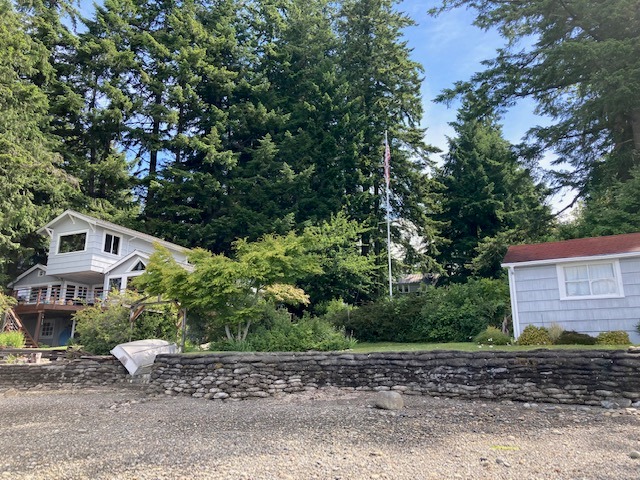
Native legend says the area was a beautiful green Eden lying beside a quiet bay. Neighbors, Ernie and Audrey Christiansen found many arrow heads on the beaches in the 1940’s reflecting the rich hunting and fishing grounds Native Americans found here.
Our family’s place was purchased in the 1930’s by the first white man to live here, Roy E. Davison. He was a Tacoma businessman who bought and built the main home for his family and professionally landscaped the almost 2 acre parcel. But when his family wasn’t interested in coming due to its isolation, he decided to sell.
In 1947, my grandparents, Homer (b. 1893) and Rhoda (b.1899) Laffaw were looking for a home as Homer had just gotten a job as sawyer at Austin Estuary mill. They’d heard that this property was for sale and came for a tour. Homer said, “It’s a beautiful place but we could never afford it.” Mr. Davison replied, “I want this home to go to a family who will enjoy and care for it as I have so I’ll sell it for a price you can afford.” They bought it for $13,700. They kept in touch with Mr. Davison until his death, always grateful for the gift of this place.
Mr. Davison had a Native American grounds keeper, Harry Hazelwood, who lived in a little cabin on the water. Harry remained when Homer and Rhoda purchased the property. When Harry left, Homer enlarged the cabin for family and friends to stay.
When the mill closed in about 1950, Homer was out of a job so both he and his younger son, Larry, worked on the oyster beds for a while. Homer then got a job as Custodian at Peninsula High School where he worked until his death in 1960.
After Homer’s death, Rhoda worked hard to keep up the place by herself, coming home from work at the Bremerton Ship Yard, eating a hardboiled egg, and going out to paint shingles or work in the gardens. Rhoda joyfully welcomed family and friends that dropped by with a delicious meal—or a martini which she enjoyed nightly.
Homer had begun building a “cottage” on the water prior to his death. The family finished this cottage, which is where Jaime and I have lived since our 1974 arrival. We then made 2 additions with the birth our 2 kids in the 1980’s. Our kids toddled up to Great Grandma Rhoda’s house every day for visits—and a spritz cookie.
In the 1950’s, neighbors and friends Vic and Irene Ouelette arranged for Rhoda to buy the tidelands in front of our place. At that time an error was found from the 1800’s survey which caused the meander line for the beach property to be 100’ upland from the bulkhead. The family consulted an attorney who found that all the property lines nearby were also incorrect. The attorney recommended that rather than pursuing legal action to instead keep up the fence lines assuring “adverse possession” should property lines ever be challenged in court.
Our family has always believed that it is our responsibility to preserve Burley Lagoon’s environment. Family members testified at a 1960’s hearing in support of Jerry Yamashita’s oyster seeding project, as we felt his practices assured the health of the Lagoon. When the project was approved, Jerry and his wife hosted a clam and oyster feast at PHS, which they’d prepared themselves, for everyone on Burley Lagoon. Our family also has been vocal about unsound environmental practices used to farm geoducks and plastics poles and predator netting used for clam and oyster production. We supported Pierce and Kitsap septic tank testing in the 1970’s which cleaned-up pollution in Burley Lagoon.
Our family has been able to keep this place thanks to the wisdom, generosity and efforts of my dad, Jack and his brother, Larry. Just before Rhoda’s death in 1992, they advised their mom to divide the property into 3 parcels in her Will: Jack’s property, Larry’s property, and family property. Since then, both Jack and Larry have gifted their properties to their children.
In 2012, the family drew up the “Laffaw Acres Family Agreement.” In discussions leading up to this Agreement, the question arose: “How can we buy out a family member who no longer wanted to or could afford to be a part of the property?” My nephew replied, “This property was a gift. No one should profit from a gift.” So with that, it was decided that anyone could opt out, still enjoy the property and not pay into improvements/taxes/etc. But at the time of possible sale, they could only receive their portion of profits if they paid all their portion of back expenses.
Today the family continues to enjoy the place for fun times with family and friends—including 5 family weddings here. Family “Work Parties” are held twice a year to keep up the place. Rules and expectations are written down and everyone is great about vacuuming, changing beds, etc. after using the place. And now the 5th generation is enjoying “Laffaw Acres!”
It is the family’s hope to hold onto this place as long as it brings our family together positively. We recall my Grandma Rhoda’s words, “If this place ever becomes a burden or causes family disagreements, then it’s time to sell it.” In the meantime, we’ll sail, paddle, or swim in the waters of Burley Lagoon and do our best to keep up this amazing pristine environment which Native Americans and Mr. Davison entrusted to us.
Burley Lagoon to Me
by Claudia Casebolt
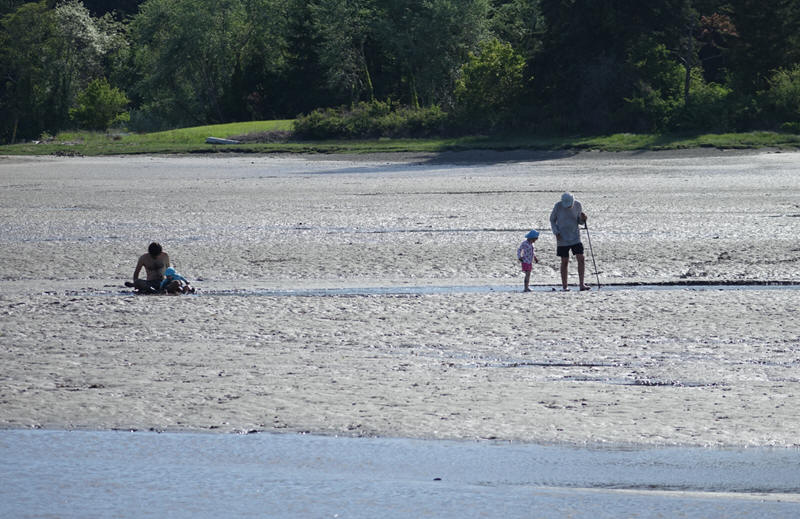
We scrimped and saved when we were young and in the mid 1980’s it was our dream come true when we were able to buy waterfront. We could only afford a place fairly deep in Burley Lagoon where there was lots of MUD. We had a good view of the water through a few huge fir trees and we left the beach wild and natural.
It’s such a peaceful place. In June the beach grasses are long and green and wild pink roses grow all along the beach. There’s also one wild volunteer pear tree. Long before we were here someone, man or bird, must have dropped a seed. You could never call that pear "Delicious" but we have named it the Burley Pear.
Along our beach there is a small, barely visible, point that I call Doubtful Point and there sits a bench for the enjoyment of any kayakers or canoers who pass by. In some summers we go canoeing almost every evening.
But mostly we’ve grown to love the mud. It is teaming with wildlife. Once or twice a year our whole family will venture out onto it. It will be warm and the kids, now with kids of their own, will make mud pies and get extremely dirty. Watching the tide carefully, we’ll usually walk across the lagoon and south to the small island in the middle. That summer of 1986 when we first bought our house my husband with our 5 year old son canoed and camped out on that island and our son christened it Treasure Island. I don’t know what other people call it but it will always be Treasure Island to us.
Burley Lagoon nurtures us and keeps us whole.
Favorite Place to Be
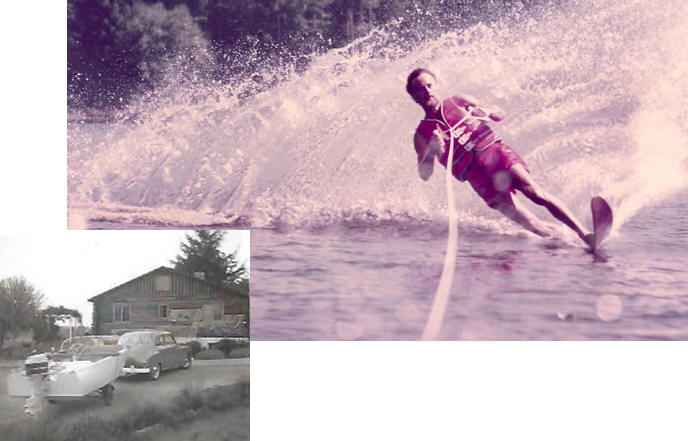
Burley Lagoon is tucked away, a hidden gem nestled in
the backwaters of Gig Harbor. My parents moved our family from the
city to live in its quiet seclusion just past the Purdy Bridge when
I was 8 years old. We lived in a log house on lagoon’s salt-fragrant
shores, and only a few neighboring homes dotted the area. Each day
I’d watch the tidewaters creep in and out of the shallow basin,
offering me a continually changing view, wonder, and adventure.
Living on the shores of this unique estuary built a medley of
special memories. I recall running and sliding on the silky seaweed,
making my way to Burley Creek. The water’s long fingers meandered
along the estuary bed at low tide and I’d stand, my legs and feet
tickled by the sole and flounder crowded there, awaiting the
incoming tide. At times I’d venture to the island to visit the lone
tree, stopping to examine the tide pools and wonders on the way. The
crabs, barnacles, sea anemones, sea stars, sand dollars, eagles,
ducks, crows, seagulls, heron and the abundant marine life were my
companions and my teachers. Cautious not to get stranded by the
perseverance of the incoming tide, I’d slip-slide back home with the
water lapping at my heels, my mud stained legs stinky with the scent
of the bay.
We didn’t have a boat but, regardless, I decided to build waterskis
in shop class during my high school freshman year. I could only
imagine skimming across the surface of the glassy water, but I
somehow believed if I built them, I would ski. The closest neighbor,
seeing my building efforts on a visit, offered to pull me behind his
small boat with a 15 horsepower motor and an old rope. After that
ride, I was hooked. I decided to build a boat of my own and worked
to earn an 18 horse power Johnson motor. During college, I built a
second boat, a ski boat, and purchased a 50 horsepower outboard. The
carpentry skills I developed, the fun I had designing, and the
satisfaction I experienced reinforced my interest in engineering. I
do believe I owe some credit to Burley Lagoon and its enticing
waters for my career.
After my childhood, I lived away from the lagoon for about ten
years, but its unique charms called me back to its shores. This time
I built a house and family rather than skis and a boat. Today I
still greet the tide daily and can see the island from our bayside
yard. When the lagoon fills on a summer day, you just might see an
old guy, gray hair in the wind, out on his handmade ski still
cutting across the water of his favorite place to be.
Don, east shore
Before and After conditions of shellfish beds in Burley Lagoon
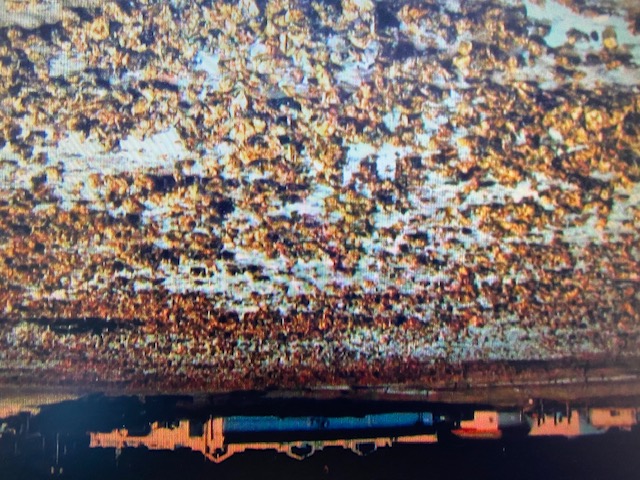
Before
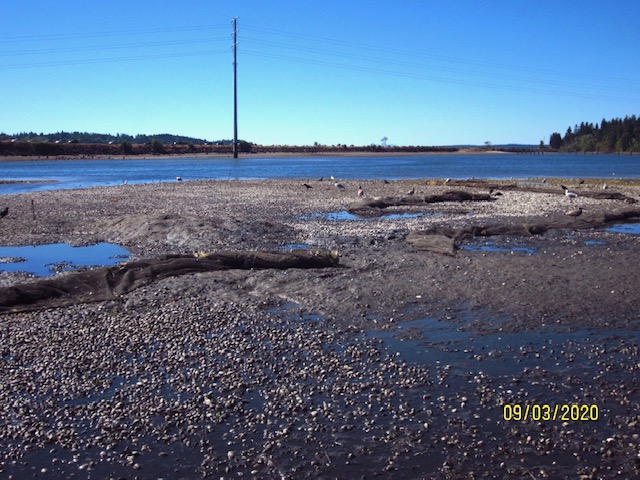
After
These two pictures are representative of Before and After
conditions of shellfish beds in Burley Lagoon.
1. Jerry Yamashita shellfish beds circa 2011 off Purdy Creek.
A natural covering of oysters atop the sediment.
2. Rolled up anti-predator (birds, crabs, etc.) netting and
thousands of “stressed manilla clams” laying atop the sediment due
to summer toxic algae bloom.
Since 2012, when the largest shellfish company on the West Coast
began leasing the Lagoon’s tidelands, disruptive changes have
occurred in the waters and on the shellfish beds.
In 2019 (see Protect Our Shoreline 9-18-2019) and 2020, two distinct
and different toxic algae blooms have affected this estuary. As
large swaths of anti-predator nets have replaced natural shellfish
beds (all along the sandspit, adjacent shorelines off Purdy Creek,
and around the natural island), when toxic algae blooms decay and
settle onto the nets and substrate, clams become “stressed”, rise to
the surface, and remain in this condition until sediment conditions
improve lasting for weeks and last summer for months.
Not only is this “beach odor” compounded by the decay, but
oftentimes it becomes a health hazard. Nets also need to be removed
and/or rolled up so “nature can run its course” and flush toxic
bacteria out the substrate and off the beach surface.
Artificial barriers, overseeding, longer lower tide cycles, low
flushing ability, low oxygen levels, and higher temperatures all
contribute to the toxic algae bloom’s effects on shellfish farming,
salmon sustainability and a healthy environment for eelgrass
allowing the once natural ecosystem continue to deteriorate.
Eastside Resident
Splish Splash
The Cycle Is Broken
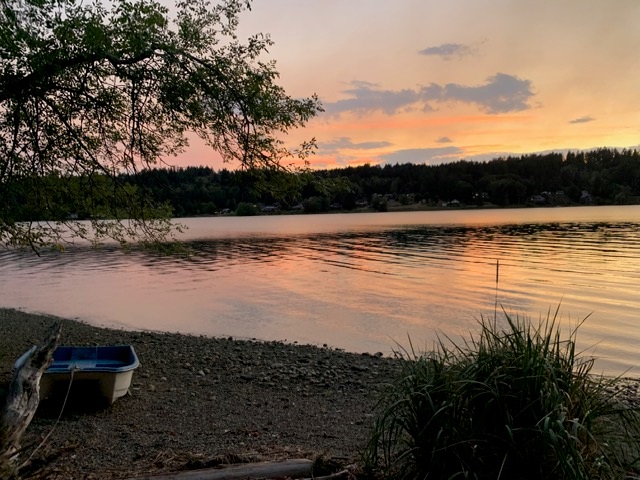
I often wonder at the instinct that propels salmon to swim,
sometimes, hundreds of miles from the ocean, to return to spawn in
their natal rivers and creeks. Once returned, they spawn, then
die, and the salmon life cycle starts over once again.
Here in Burley Lagoon, when the air turned crisp and the leaves
turned colors, crowds of salmon used to return to spawn in Purdy
Creek and Burley Creek. The salmon would stay in Burley Lagoon,
feeding until nature called them back to the creeks.
While the salmon were swimming and feeding in the Lagoon, what a
show they would put on, leaping out of the water and, with a big
twist, slapping back down! We would try to determine the size of
each salmon by the rings and ripples the salmon left on the water’s
surface. Then nature called, and they swam back to Purdy Creek and
Burley Creek, starting the salmon life cycle once again.
Now in Burley Lagoon, we see plastic, predator-exclusion nets spread
out on the tidelands for commercial shellfish aquaculture
operations. What appear to have been the natural migrating passages
for spawning salmon to Purdy and Burley Creeks have plastic,
predator-exclusion nets stretched over their substrate.
Who can tell us that these plastic nets are not interrupting the
return of the spawning salmon? The cycle of life for returning,
spawning salmon appears to be broken in Purdy Creek and Burley
Creek. Why are we allowing this to happen? What will it take to
bring the salmon back?
Who can answer this question?
Janey, Burley Lagoon resident
A Pioneer Perspective
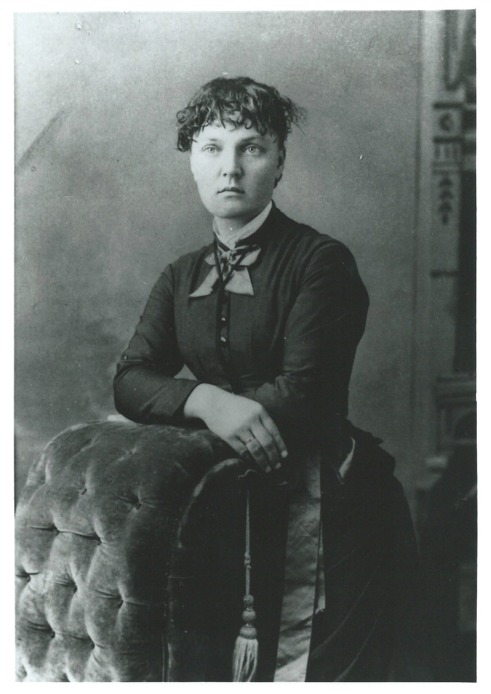
Josephine Fuller Knapp
Two of my ancestors made homestead claims on Burley Lagoon in
1884. My family has been blessed to live here ever since. We have
enjoyed the beauty, the nature, the recreation, and the hometown
feel of Burley Lagoon with each passing generation.
Before there were roads, bridges, or ferries, my family rowed all
the way between Burley Lagoon and Tacoma to get supplies, see a
doctor, or visit friends. Neighbors greeted weary travelers with a
fire on the beach, a pot of beans, a loaf of bread, and a cup of hot
coffee. My great grandmother reported the tall firs, cedars, and
maple trees, along with abundant game, and wild shellfish at her
father’s homestead on Burley Lagoon. She wrote, “With a shake, one
could get a bucket of clams in a few minutes.”
We believe that the Burley Lagoon is a unique and beautiful place.
It is here to be enjoyed by the residents (whether brand new, or
from pioneer stock). It should be protected for the wildlife, the
people who live and play here, and for the timeless beauty it
provides. We have watched shellfish companies come and go on the
shores of Burley Lagoon. All we ask is that the industrial shellfish
companies respect those of us (people, plants, and animals) who live
and play here. We ask that that they share the lagoon with the rest
of us, and not put profits ahead of all the other valuable parts of
our bay.
-Wendy (5th generation resident on the shores of Burley Lagoon)
